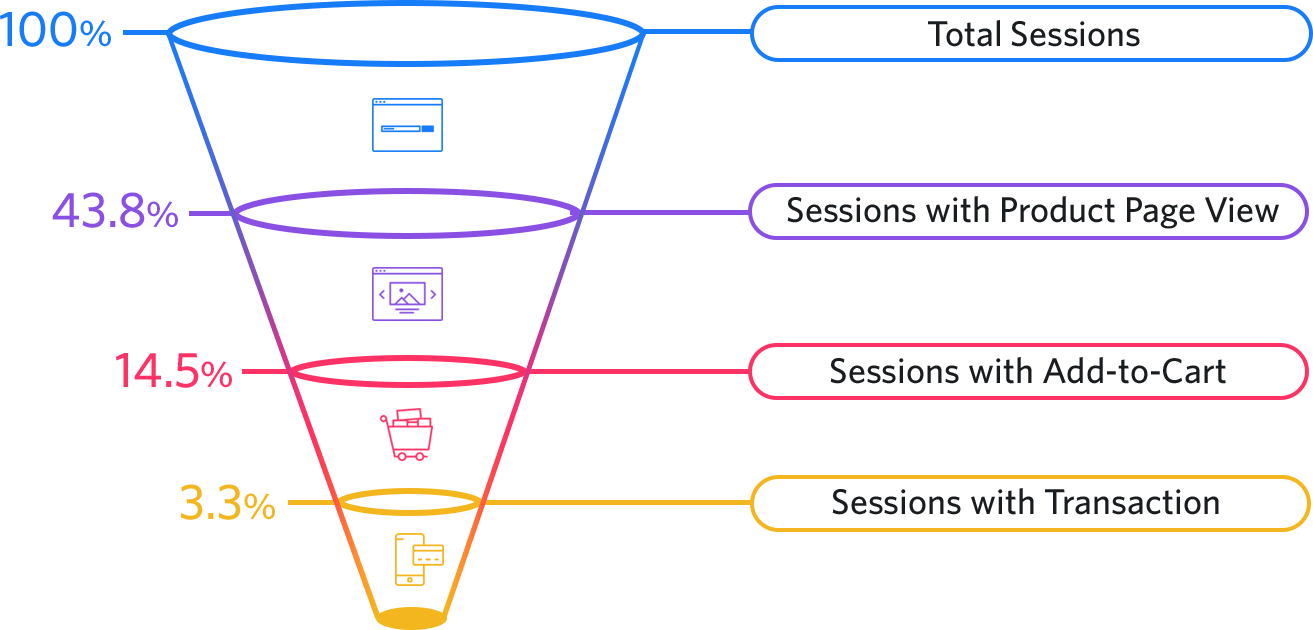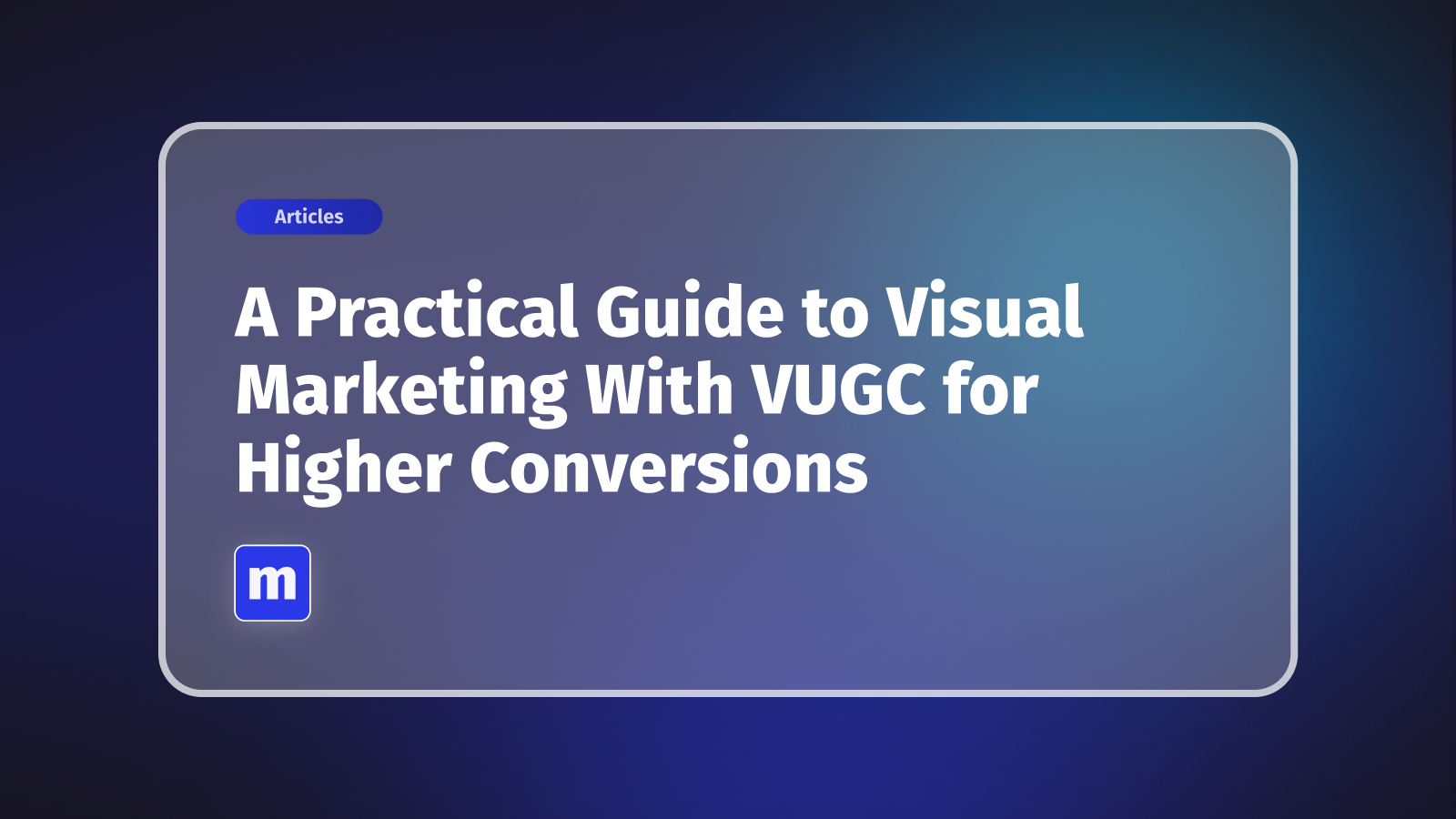.jpg)
Jump to section:
- Understanding Conversion Rate: defining ecommerce conversion rates and understanding why it’s crucial for the success of online businesses.
- Conduct a Conversion Rate Audit: a look at the importance of assessing your current conversion rate and how to track it properly.
- Optimize Your Website for Speed and Mobile: the connection between website speed, mobile-friendliness, and conversion rate and practical tips on optimizing website loading times.
- Streamline the Checkout Process: discussing the checkout process as a critical point in the conversion funnel and providing strategies to simplify and optimize the checkout process.
- Implement A/B Testing: Introducing A/B testing and its role in conversion rate optimization.
- Leverage Social Proof and Trust Signals: the psychology behind social proof and trust signals with examples
In the fast-paced world of ecommerce, where every click and scroll counts, there's one metric that stands as a beacon of success – the ecommerce conversion rate. It's the magical number that transforms casual browsers into devoted customers and ultimately determines the fate of your online business.
Picture this: Your ecommerce website is bustling with traffic. Visitors are browsing your products, adding items to their carts, and yet, the sound of the virtual cash register remains oddly silent. That's where the conversion rate comes into play – the pivotal factor that separates window shoppers from loyal patrons.
You've landed on this article because you understand that a high conversion rate isn't just a vanity metric; it's the lifeblood of your digital storefront. You're on a quest to not just boost your conversion rate, but to do it now. And that's precisely what we're here to help you achieve.
We recently wrote about how to conduct a CRO audit for your online store. In the next few minutes, we'll unravel five powerful strategies that can catapult your ecommerce conversion rate to new heights. These aren't vague theories or generic advice; these are actionable steps you can implement today. Whether you're a seasoned online merchant or just dipping your toes into the world of ecommerce, these insights will be your trusted companions on the journey to higher sales, happier customers, and a thriving online business.
So, fasten your seatbelts and prepare to embark on a conversion-boosting adventure. Your ecommerce success story starts here and now.
Understanding Conversion Rate
In the dynamic realm of ecommerce, understanding the conversion rate is akin to holding the compass that guides your ship through uncharted waters. But what exactly is this elusive metric?
Defining Ecommerce Conversion Rate
At its core, the ecommerce conversion rate is a straightforward ratio: the number of completed actions (usually purchases) divided by the total number of visitors. This percentage represents the effectiveness of your website in turning visitors into customers. A high conversion rate indicates a well-optimized and compelling user experience, while a low rate signals room for improvement. See more from Shopify on how they define what a good ecommerce conversion is.
The Crucial Significance
Why should you be keeping a watchful eye on this seemingly simple percentage? The answer lies in its direct correlation to your bottom line. A higher conversion rate means more revenue, plain and simple. It's the difference between a website that merely exists and one that thrives in the competitive world of ecommerce.
The Impact of a High Conversion Rate
Consider this scenario: By making subtle yet strategic changes to your website, you can double your conversion rate. Suddenly, the same amount of traffic translates into twice the number of sales. That's the power of conversion rate optimization. It's not about just getting more traffic; it's about making the most of the traffic you already have.
In the next section, we'll delve into the crucial steps of conducting a conversion rate audit, laying the foundation for targeted improvements that will skyrocket your conversion rate.

Conduct a Conversion Rate Audit
Before you embark on the journey to boost your ecommerce conversion rate, it's essential to know where you currently stand. This is where a thorough conversion rate audit comes into play.
The Importance of a Conversion Rate Audit
Imagine setting out on a cross-country road trip without a map or GPS. You might reach your destination eventually, but the journey will be filled with unnecessary detours and frustrations. Similarly, optimizing your conversion rate without understanding your starting point can be a hit-or-miss endeavor.
Calculating Your Current Conversion Rate
Start by calculating your existing conversion rate. This is done by dividing the number of completed conversions (purchases) by the total number of visitors during a specific period. Most commonly, this is expressed as a percentage. For example, if you had 1000 visitors and 50 of them made a purchase, your conversion rate would be 5%. Optimizely recently put together a helpful guide on calculating conversion rates.
Utilizing Tools for In-Depth Analysis
Tools like Google Analytics can provide a treasure trove of data about your website's performance. Beyond the overall conversion rate, you can gain insights into conversion rates for specific pages, traffic sources, and even device types. This data is invaluable for pinpointing areas that require attention.
Common Conversion Rate Challenges
During your audit, keep an eye out for common conversion rate pitfalls. These may include complicated checkout processes, slow-loading pages, unclear product descriptions, or lack of trust signals. Identifying these issues is the first step towards resolving them.
Once you've conducted a thorough audit and have a clear understanding of your baseline conversion rate, you're ready to embark on the journey of optimization. In the following sections, we'll explore actionable strategies to address the issues uncovered during your audit and supercharge your conversion rate.
.svg)
Optimize Your Website for Speed and Mobile
In today's fast-paced digital landscape, speed and mobile-friendliness are paramount. A slow-loading website or a poorly optimized mobile experience can be the Achilles' heel of your ecommerce conversion rate. Let's explore specific strategies and examples to address these critical aspects.
Improve Website Speed:
- Optimize Images: Large, unoptimized images can significantly slow down your website. Use image compression tools like TinyPNG or ImageOptim to reduce file sizes without compromising quality.
- Leverage Browser Caching: Implement browser caching to store static resources (e.g., images, CSS, and JavaScript) locally on a user's device, reducing load times for repeat visitors.
- Content Delivery Networks (CDNs): Utilize CDNs like Cloudflare or Amazon CloudFront to distribute website content across multiple servers worldwide, minimizing loading times for users in different regions.
- Minify CSS and JavaScript: Remove unnecessary spaces and characters from your CSS and JavaScript files to reduce their size and improve load speed.
Enhance Mobile-Friendliness:
- Responsive Design: Ensure your website employs responsive design principles, which automatically adjust the layout and content to fit various screen sizes and devices.
- Mobile-First Approach: Consider adopting a mobile-first design philosophy. Start with the mobile version of your site and then scale up for larger screens. Google also favors mobile-first indexing.
- Accelerated Mobile Pages (AMP): Implement AMP for product pages and articles to create lightning-fast mobile experiences. AMP is a Google-backed initiative for mobile optimization.
- Test on Real Devices: Regularly test your website on real mobile devices to ensure that it functions smoothly and looks appealing on various smartphones and tablets.
Steps Birchbox took to improve their website speed
Birchbox, a well-known beauty and grooming subscription service, provides an excellent illustration of optimizing for speed and mobile-friendliness on their ecommerce website. Birchbox employs several strategies to ensure a seamless user experience, both on desktop and mobile devices:
- Image Optimization: Birchbox optimizes product images, ensuring that high-quality visuals load quickly. This practice enhances the overall shopping experience, especially on mobile devices with varying internet speeds.
- Responsive Design: Birchbox's website is built with a responsive design that adjusts content and layout to fit screens of different sizes. This responsive approach guarantees a user-friendly interface across devices, from smartphones to desktops.
- Mobile-Specific Features: Birchbox's mobile site includes mobile-specific features such as simplified navigation and user-friendly menus. This approach acknowledges the unique needs and behaviors of mobile shoppers.
- Regular Testing: Like any forward-thinking ecommerce company, Birchbox performs regular testing on various mobile devices to identify and rectify any issues. This proactive approach ensures that customers can shop effortlessly, regardless of the device they use.
By observing Birchbox's optimization strategies, you can gain insights into how a successful ecommerce company tackles speed and mobile-friendliness. These practices can be adapted to benefit your own online store.

Streamline the Checkout Process
Imagine you're in a physical store, ready to make a purchase, but the checkout counter is hidden in a maze, the cashier is hard to find, and you're asked a barrage of irrelevant questions before you can complete your transaction. Frustrating, isn't it? The online equivalent of this scenario is a complex and time-consuming checkout process, which can be a major conversion killer. Here's how to streamline it:
Simplify the Steps:
- Single-Page Checkout: Consider implementing a single-page checkout process. This condenses all necessary fields onto one page, reducing the steps customers must take to complete their purchase.
- Guest Checkout: Allow customers to check out as guests without requiring them to create an account. While you can encourage account creation, make it optional, not mandatory.
Clear Progress Indicators:
- Progress Bar: If you use a multi-step checkout, provide a progress bar to show customers how far along they are in the process. Knowing they are near the finish line can encourage them to complete the purchase.
Minimize Distractions:
- Remove Navigation: During checkout, remove distractions such as the main navigation menu to keep customers focused on the task at hand.
Payment Options
- Offer Various Payment Methods: Accept a variety of payment options, including credit cards, digital wallets (e.g., PayPal), and even buy-now-pay-later services (e.g., Klarna or Afterpay). Give customers the flexibility to choose their preferred payment method.
Security and Trust
- Display Trust Seals: Place trust seals and security badges prominently during checkout to reassure customers that their information is safe. Trust signals can significantly improve conversion rates.
Shopify excels at improving the checkout process for customers
Shopify, a leading ecommerce platform, offers a streamlined and user-friendly checkout process. They have a single-page checkout with clear progress indicators. Customers can check out as guests or create an account, and they support various payment methods, including credit cards and digital wallets. Shopify also displays trust badges, ensuring a secure and trustworthy shopping experience.
By adopting these strategies and learning from successful ecommerce platforms like Shopify, you can create a checkout process that minimizes friction, boosts conversions, and leaves your customers with a positive impression.
In the next section, we'll explore the power of A/B testing in optimizing your ecommerce conversion rate.
Implement A/B Testing
In the world of ecommerce, achieving the highest conversion rate possible is an ongoing journey. One powerful tool in your arsenal is A/B testing, also known as split testing. It allows you to make data-driven decisions to optimize your website and boost conversions. Here's how to effectively implement A/B testing:
Understanding A/B Testing:
- What is A/B Testing: A/B testing involves creating two (A and B) versions of a web page, email, or element (e.g., a button or headline) with one element being different between the two. You then show these versions to different sets of users to determine which one performs better in terms of conversion.
Identifying Elements to Test:
- Start with Key Pages: Begin by focusing on key pages in your conversion funnel, such as product pages, checkout, or landing pages.
- Testing Elements: Elements that are often tested include headlines, images, call-to-action buttons, form fields, product descriptions, and even page layout.
Setting Up A/B Tests:
- Hypothesize Changes: Before running a test, create a hypothesis about which change will lead to better conversions. For example, you might hypothesize that changing the color of the "Buy Now" button to green will increase clicks.
- Random Assignment: Ensure that users are randomly assigned to either the control group (A) or the variant group (B). This helps eliminate bias in your results.
Running the Test:
- Run Simultaneously: Test both versions simultaneously to account for external factors that could affect results (e.g., time of day or week).
- Collect Data: Gather data on user interactions, such as clicks, conversions, bounce rates, and session duration, for both versions.
Analyzing Results:
- Statistical Significance: Use statistical analysis to determine if the differences in conversion rates between A and B are statistically significant. Tools like Google Optimize or Optimizely can help with this.
Implementing the Winning Variant:
- After identifying the winning variant, implement the changes on your website to improve the overall conversion rate.
Airbnb, a pioneer in the online marketplace industry, continuously conducts A/B testing to enhance user experience and increase conversion rates. They test various elements, including the wording and design of their booking buttons, pricing displays, and even the placement of user reviews. These tests help Airbnb make data-driven decisions and continuously optimize their platform.
By incorporating A/B testing into your ecommerce strategy, you can fine-tune your website and marketing efforts to better resonate with your audience and drive more conversions. It's a dynamic process that can lead to substantial improvements in your bottom line.

Leverage Social Proof and Trust Signals
In the world of ecommerce, trust is currency, and social proof is your most valuable asset. Shoppers often look to the experiences of others to make informed decisions. Leveraging social proof and trust signals can significantly boost your ecommerce conversion rate. Here's how to do it effectively:
The Power of Social Proof:
- Customer Reviews and Ratings: Encourage satisfied customers to leave reviews and ratings for your products. Display these prominently on product pages to showcase real user experiences and build trust.
- User-Generated Content: Share user-generated content, such as customer photos and testimonials, to provide authentic endorsements of your products or services.
Moast is a great platform to capture both interactive and authentic testimonials as well as user-generated content.
Trust Signals:
- Security Badges: Display security badges and certifications, such as SSL certificates and payment security icons, to assure customers that their personal and financial information is safe.
- Shipping and Return Policies: Clearly communicate your shipping and return policies. Transparency in these areas can alleviate concerns and build trust.
Social Media Presence:
- Active Social Media Profiles: Maintain active and engaging social media profiles. Showcase your following, user interactions, and positive feedback from customers.
- Influencer Endorsements: Collaborate with influencers or industry experts to endorse your products or services on social media. Influencer marketing can enhance credibility.
Case Studies and Success Stories:
- Highlight Success Stories: Share case studies or success stories of satisfied customers who have achieved significant results with your products or services.
Oru Kayaks, a company that designs innovative folding kayaks, has mastered the art of capturing reviews from customers and building trust with their shoppers.
.svg)
Customer Reviews and Testimonials: Oru Kayaks actively encourages their customers to share their kayaking experiences and product reviews. They prominently display these reviews on their website, with a dedicated section for customer testimonials. Potential buyers can see firsthand accounts of other customers enjoying their kayaks, which instills confidence in the product's quality and performance. They also feature Moast’s interactive testimonial platform that allows hesitant shoppers to connect with real customers in their communities either virtually or in-person.
User-Generated Content: Oru Kayaks promotes user-generated content through social media campaigns. They encourage customers to share photos and videos of their kayaking adventures using the hashtag #MyOruAdventure. These authentic user experiences serve as compelling endorsements of the brand and its products.
Social Media Engagement: Oru Kayaks maintains an active presence on social media platforms, where they engage with customers, respond to inquiries, and share user-generated content. Their social media profiles showcase a community of kayaking enthusiasts who have embraced the brand and its products.
Influencer Collaborations: Oru Kayaks has collaborated with outdoor and adventure influencers who share their kayaking experiences with a wider audience. These influencers provide third-party validation and expand the reach of Oru Kayaks' message.
By effectively leveraging customer reviews, user-generated content, social media engagement, and influencer collaborations, Oru Kayaks has built a strong sense of trust and community around its brand. This approach not only attracts new customers but also fosters loyalty among existing ones.
Certainly, let's conclude the article with a fitting title for the conclusion:
Empowering Your Ecommerce Success by Improving E-Commerce Conversion Rates
In the ever-evolving landscape of ecommerce, achieving a high conversion rate is the golden ticket to growth and prosperity. Throughout this journey, we've explored five powerful strategies to help you improve your ecommerce conversion rate and empower your online success. Let's recap the 5 tips:
- Conducting a Conversion Rate Audit: To embark on the path of improvement, you must first know where you stand. Conducting a thorough conversion rate audit reveals the areas in need of attention.
- Optimizing for Speed and Mobile: We discussed the significance of a speedy website and mobile-friendliness and provided practical strategies, including image optimization, responsive design, and mobile-first approaches.
- Streamlining the Checkout Process: Simplifying the checkout process minimizes friction and increases the likelihood of completed transactions. We explored techniques like single-page checkouts and trust-building measures.
- Implementing A/B Testing: Harness the power of data-driven decision-making through A/B testing. Test various elements on your website to identify what resonates best with your audience.
- Leveraging Social Proof and Trust Signals: We emphasized the importance of trust in ecommerce and showcased real-world examples like Oru Kayaks, where customer reviews, user-generated content, and trust signals foster trust and loyalty.
As you embark on your journey to improve your ecommerce conversion rate, remember that optimization is an ongoing process. Continuously monitor, adapt, and refine your strategies to keep up with changing consumer behaviors and preferences.
Your ecommerce success story starts with understanding, optimization, and trust-building. By implementing these strategies, you're better equipped to capture the attention of potential customers, engage them effectively, and ultimately convert them into loyal patrons of your brand.
Related content
Turn your social content into a revenue channel
Turn your TikToks and Reels into shoppable videos and boost conversions by 3.5x.













